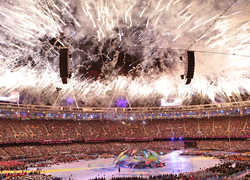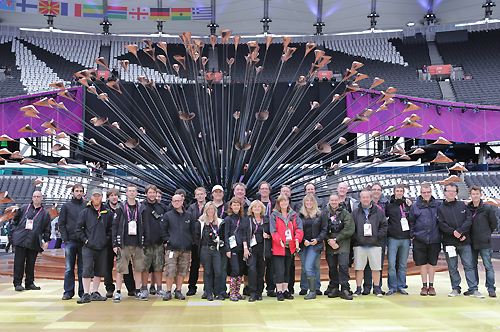
Design Principle
Most of my previous designs have used a distributed ground based source to localize the lower bowl audience to the performance area.
In my experience there is a perceived improvement as a result of dividing coverage between the upper and lower bowl areas.
So the design process for London 2012 began based around a ring of flown arrays for the upper bowl and a ring of ground stacked arrays for the lower bowl.
My design process worked to achieve the best possible vertical coverage with the minimum quantity of elements, and then to use the minimum quantity of arrays to deliver the best possible horizontal coverage.
Achieving the minimum power requirements is addressed from the outset by selecting the appropriate line source product.
A large area in the stadium was devoted to the world’s media. The TV media were located in a section of the lower bowl. The press were in the same section of the stadium but in the upper bowl.
Each rights’ holding broadcaster from around the world had a commentary position in the lower bowl media tribune where they could watch the Ceremonies and comment on the show.
The commissioning process specifications set out that we were to attenuate the lower bowl media tribune. This allowed the commentary to be as clean as possible while still providing the commentators with an enveloping and exciting experience.
Ultimately the lower bowl media area was 6 dB down on the rest of the stadium and the upper bowl did not require any attenuation.
Alternating Left/Right
We attempted to deliver some kind of stereophonic experience to as many listeners as possible. Though it is often very difficult to perceive in distributed designs, the signal path to the flown and ground stacked arrays was configured for an alternating left/right layout.
Athletics
It was decided early on that the flown Ceremonies loudspeaker system would also be used for athletics. This required the flown arrays to be augmented with additional product to extend coverage to the lower bowl. This additional coverage was switched off for the Ceremonies.
Loudspeaker Locations
A continuous rigging beam or fixing edge was installed following the oval shape of the field of play perimeter. It was designed to place the fixing edge approximately 30 meters on-field of the existing roof edge, at a trim height of approximately 30 meters from the field. Geometrically, this is the ideal location for the flown arrays.
The fixing edge itself was simply a 48mm flexible steel wire rope ring supported by 56 smaller diameter radial wire ropes which tied into the roof support system. Each flown array had to be located on a junction between the tension ring and a radial rope to provide stabilization. The flown positions also had to consider the location of the Olympic caldron and other significant set pieces.
The Design Process Itself
This stadium was an unusual case for me as it was already built, so not only did I have accurate CAD files, but I could also walk around the venue to develop a more realistic sense of how the design would fit into the building.
The design process began with creating an EASE model from the CAD files. This model was used to audition alternative products to arrive at the final five design alternatives, which included the L-Acoustics option. Once we had determined the final five alternatives the detailed design phase began.
The L-Acoustics design was created in SOUNDVISION 3D SIMULATION with some reverberant field analysis in EASE.


